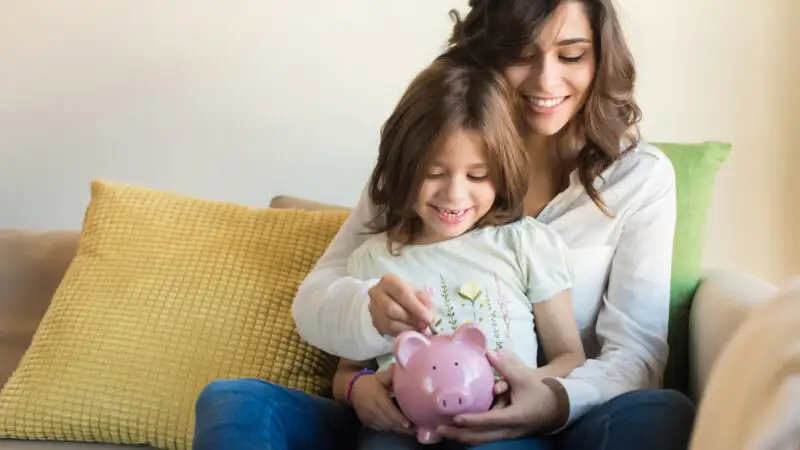Disclosure: This post may contain affiliate links, meaning we get a commission if you decide to make a purchase through our links, at no cost to you. Please read our disclosure for more info.
Teaching kids anything can be a difficult task, even if they are willing to absorb as much information as they can. Their attention span may be cut short, or there may be something that they are far more interested in than how to lock the front door. When it comes to safety, teaching kids the right thing to do is paramount. Although it may be a struggle, once they have learned these skills at an early age, they will have no trouble resorting to them naturally throughout their life.
To help you encourage the best habits for your kids, it is worth taking note of these simple tips.
In This Post:
Teach Them the Value of Money
Before you start to teach your child how to keep belongings safe, it is key to talk to them about why. At a young age, kids won’t know the difference between a toy and a cell phone, and the only thing that will make one more important than the other is the emotional attachment they form with an object. When they are made aware of what is classed as valuable, they will start to reach an awareness on which items need protecting, and which don’t. Helping them understand the value of money is a great start, as they will then be able to comprehend what would happen if something expensive were to be stolen. However, lots of possessions in your home will be inexpensive but important, so you can begin by stressing how if your mother’s china plates were to be damaged, it would be the same as if their favorite toy was broken.
Show Them What Happens When Belongings Aren’t Safe
Sometimes a child might grasp that keeping belongings safe is a good thing, but they won’t understand the severity of doing so. Without scaring them, it’s wise to talk through what would happen if their belongings weren’t safe, or offer a form of visual representation. This will make it so that your child doesn’t have safety at the back of their minds, but at the front when needed. It is imperative to do this without invoking feelings of anxiety in your child, as this could lead to unnecessary worry when they start to grow up. Showing them the dangers, but also telling them that the problem is solvable and wouldn’t be their fault, are only two ways you can combat this issue before it arises.
Make Small Habits Organic
Safety can come in many forms, but the everyday acts of safety around the home are those that should take precedence. For example, shutting the windows and locking them before you go to sleep, or turning the alarm on when you leave the house. When you are going through the motions, capture the attention of your child and remind them to take a look at how you are carrying out the task. Sometimes, it could even be a good idea to ask them to help you or do it for you. The more regularly this happens, the more ingrained these habits will become for your child. In no time, they will be able to carry out the simplest safety measures if you have taught them effectively. Once you have combated such small tasks, then you can think about moving onto showing them what else they can do.
Encourage Safety Outside the Home
is an issue that should never be ignored, as it is crucial to the daily leading of everyone’s life in your home. Though safety starts here, it doesn’t mean it should end there. Giving them the right habits to practice from is a good start, but you can also give them the tools to keep their belongings safe. For example, the recent rise of bike thefts means that simply being aware of this danger isn’t enough to keep your kid’s bike protected when they go to school or a friend’s house.
Getting them equipment like an uncuttable bike lock or a secure code will help them. The best thing about this is that if other children see your child being wary of the possible dangers, they will be more inclined to follow in their example.
Practice What You Preach
Teaching children can only get you so far. Kids are smart, and they will be able to spot if you are being serious with them, or if your mind is somewhere else. If they notice that something you have told them doesn’t match up to how you go about your daily life, then there could be problems with how you convey the importance of what you are trying to teach. As with most things, actions speak louder than words. You may be telling your child to act a certain way, but if you don’t act like you believe it, or you go against the grain of what you have been saying, then they are far less likely to listen. You might forget to turn the television off by the plug when you go to bed, but rescue this situation by admitting your mistake and addressing it head-on, so your child knows that it isn’t something they should think about doing.
Don’t Just Talk About Burglary
When you talk about safety and possessions, the easiest conclusion to jump to is that burglary and theft are the main dangers to worry about. Yet fire safety and other health and safety issues can also pose as threats to your belongings. Although it is important to educate your children on burglary, your life skills should also include references to how they should keep the house clean to prevent dirt from damaging your home, and how they can minimize the risk of a fire starting. When it comes to fires, there are a multitude of educational resources out there that aim to keep your child entertained, while also informing them on what to do to prevent fires. You can find them online, but you can also think about making your own resource for your child to turn to.




